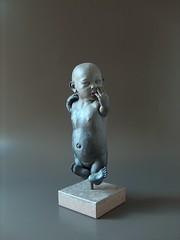The Steno Museum for the history of science and medicine at Aarhus University has produced some very interesting temporary exhibitions over the past few years (see fx here). Their latest contribution deals with congenital deformities in children, and takes an historical as well as an artistic approach to the challenge of culturally accomodating the issue of birth defects.
Here is what Morten A. Skydsgaard, head curator of the exhibition, writes about the show:
“Congenital deformities have always fascinated and disgusted us – and calls for further explanation.
The exhibition ”The incomplete child”, at the Steno Museum, The Danish Museum for the History of Science, shows how science, art and society have viewed children with congenital deformities through history. Mythical figures, different chemical substances and the chromosome 21 are all important explanations in the broad narrative of the exhibition about our efforts to understand, delineate and alleviate the different and deform.
The artist Heidi Guthmann Birck’s stone sculptures of foetuses with deformities are an important component of the exhibition, and the sculptures show the ambivalence which strike many of us when meeting the imperfect: Fascination and revulsion.

Technology also plays a vital role in the exhibition. Better ways of communicating and better transport as well as new medical treatments have meant that handicapped children today are more and more independent. At the same time early diagnosis of foetal deformities threatens the lives of the different and deform, because parents today can choose to abort foetuses with illnesses or defects.
The exhibition is aimed at general audience, and it makes an effort to reach school children and thus fulfil a didactic purpose important to the Steno Museum. One way to do so is to offer educational material in the area of prenatal diagnostics as well as inviting visitors to take part in discussions of the ethical aspects of these new technologies.”
The exhibition is accompanied by an anthology edited by Morten A. Skydsgaard and Lise Funder. Among the contributions there is a chapter by Lars Ole Andersen, external lecturer at Medical Museion, on 19th century ideas about the potentially dangerous effects of women’s imagination on unborn children.
Also, Ion Meyer, Head of Collections at Medical Museion, has written a chapter on the problems of exhibiting deformed foetuses and children, largely drawing on experiences from Museum Saxtorphianum, Medical Museion’s collection of dry and wet specimens of children and foetuses with congenital deformities.
The exhibition is on until 2 February, so there is still time to catch it.



